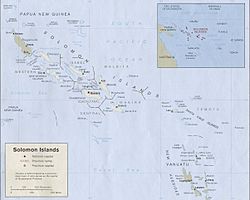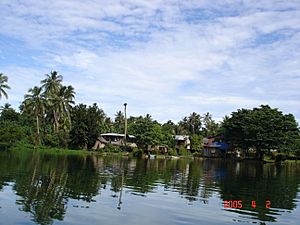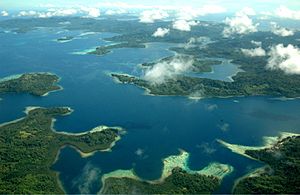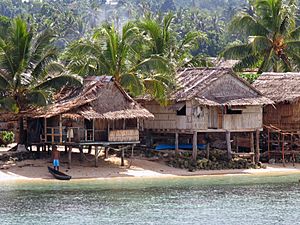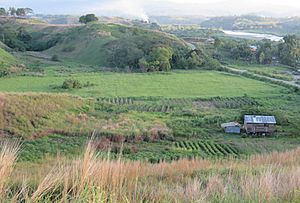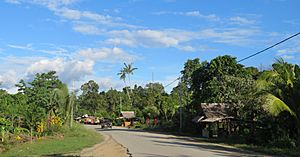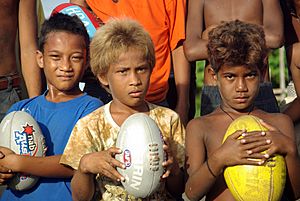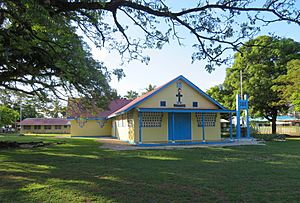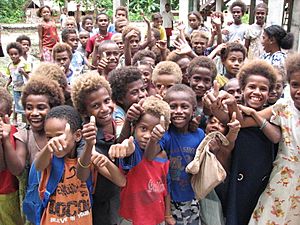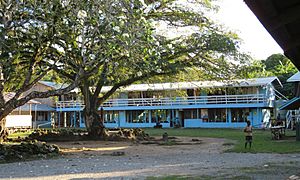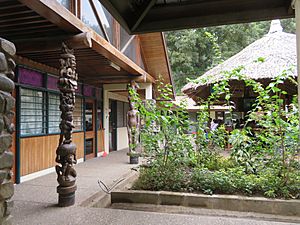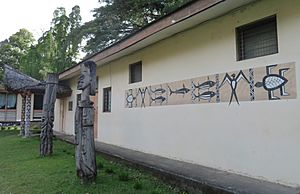Solomon Islands facts for kids
Quick facts for kids
Solomon Islands
Solomon Aelan (Pijin)
|
|
|---|---|
|
|
|
|
Motto: "To Lead is to Serve"
|
|
|
Anthem: "God Save Our Solomon Islands"
|
|
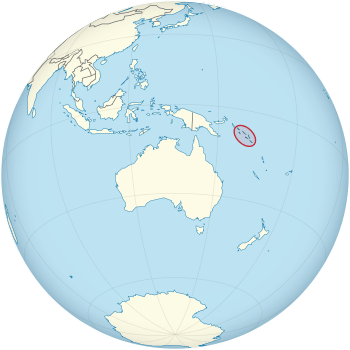 |
|
| Capital and largest city
|
Honiara 9°25′55″S 159°57′20″E / 9.43194°S 159.95556°E |
| Official languages |
|
| Ethnic groups
(2016)
|
|
| Religion
(2016)
|
|
| Demonym(s) | Solomon Islander Solomonese |
| Government | Unitary parliamentary constitutional monarchy |
|
• Monarch
|
Charles III |
| David Tiva Kapu | |
| Jeremiah Manele | |
| Legislature | National Parliament |
| Independence | |
|
• from the United Kingdom
|
7 July 1978 |
| Area | |
|
• Total
|
28,896 km2 (11,157 sq mi) (139th) |
|
• Water (%)
|
3.2% |
| Population | |
|
• 2023 estimate
|
734,887 (167th) |
|
• 2019 census
|
721,956 |
|
• Density
|
24.2/km2 (62.7/sq mi) (200th) |
| GDP (PPP) | 2024 estimate |
|
• Total
|
|
|
• Per capita
|
|
| GDP (nominal) | 2024 estimate |
|
• Total
|
|
|
• Per capita
|
|
| Gini (2013) | medium |
| HDI (2022) | medium · 156th |
| Currency | Solomon Islands dollar (SBD) |
| Time zone | UTC+11 (Solomon Islands Time) |
|
• Summer (DST)
|
Solomon Islands does not have an associated daylight saving time |
| Driving side | left |
| Calling code | +677 |
| ISO 3166 code | SB |
| Internet TLD | .sb |
Solomon Islands is an island country consisting of six major islands and over 900 smaller islands in Oceania, to the east of Papua New Guinea and northwest of Vanuatu. It has a land area of 28,400 square kilometres (11,000 sq mi), and a population of about 700,000. Its capital, Honiara, is located on the largest island, Guadalcanal. The country takes its name from the Solomon Islands archipelago, which is a collection of Melanesian islands that also includes the North Solomon Islands (a part of Papua New Guinea), but excludes outlying islands, such as the Santa Cruz Islands and Rennell and Bellona.
The islands have been settled since at least some time between 30,000 and 28,800 BCE, with later waves of migrants, notably the Lapita people, mixing and producing the modern indigenous Solomon Islanders population. In 1568, the Spanish navigator Álvaro de Mendaña was the first European to visit them. Though not named by Mendaña, it is believed that the islands were called "the Solomons" by those who later received word of his voyage and mapped his discovery. Mendaña returned decades later, in 1595, and another Spanish expedition, led by Portuguese navigator Pedro Fernandes de Queirós, visited the Solomons in 1606. Britain defined its area of interest in the Solomon Islands archipelago in June 1893, when Captain Gibson, R.N., of HMS Curacoa, declared the southern Solomon Islands a British protectorate. During World War II, the Solomon Islands campaign (1942–1945) saw fierce fighting between the United States, British Commonwealth forces and the Empire of Japan, including the Battle of Guadalcanal.
The official name of the then-British administration was changed from the "British Solomon Islands Protectorate" to "The Solomon Islands" in 1975, and self-government was achieved the following year. Independence was obtained, and the name changed to just "Solomon Islands" (without the definite article), in 1978. At independence, Solomon Islands became a constitutional monarchy. The King of Solomon Islands is Charles, who is represented in the country by a governor-general.
Contents
Provinces
The country is divided into nine provinces and the town of Honiara.
- Central
- Choiseul
- Guadalcanal
- Isabel
- Makira-Ulawa
- Malaita
- Rennell and Bellona
- Temotu
- Western
- Honiara City
Geography
Solomon Islands is an island nation that lies east of Papua New Guinea and consists of many islands: Choiseul, the Shortland Islands; the New Georgia Islands; Santa Isabel; the Russell Islands; Nggela (the Florida Islands); Malaita; Guadalcanal; Sikaiana; Maramasike; Ulawa; Uki; Makira (San Cristobal); Santa Ana; Rennell and Bellona; the Santa Cruz Islands and the remote, tiny outliers, Tikopia, Anuta, and Fatutaka.
The country's islands lie between latitudes 5° and 13°S, and longitudes 155° and 169°E. The distance between the westernmost and easternmost islands is about 1,500 kilometres (930 mi). The Santa Cruz Islands (of which Tikopia is part) are situated north of Vanuatu and are especially isolated at more than 200 kilometres (120 mi) from the other islands. Bougainville is geographically part of the Solomon Islands archipelago but politically part of Papua New Guinea.
Climate
The islands' ocean-equatorial climate is extremely humid throughout the year, with a mean temperature of 26.5 °C (79.7 °F) and few extremes of temperature or weather. June through August is the cooler period. Though seasons are not pronounced, the northwesterly winds of November through April bring more frequent rainfall and occasional squalls or cyclones. The annual rainfall is about 3,050 millimetres (120 in).
Ecology
The Solomon Islands archipelago is part of two distinct terrestrial ecoregions. Most of the islands are part of the Solomon Islands rain forests ecoregion, which also includes the islands of Bougainville and Buka; these forests have come under pressure from forestry activities. The Santa Cruz Islands are part of the Vanuatu rain forests ecoregion, together with the neighbouring archipelago of Vanuatu. Soil quality ranges from extremely rich volcanic (there are volcanoes with varying degrees of activity on some of the larger islands) to relatively infertile limestone. More than 230 varieties of orchids and other tropical flowers brighten the landscape. Mammals are scarce on the islands, with the only terrestrial mammals being bats and small rodents. Birds and reptiles, however, are abundant.
The islands contain several active and dormant volcanoes. The Tinakula and Kavachi volcanoes are the most active.
Government
Solomon Islands is a constitutional monarchy and has a parliamentary system of government. As King of Solomon Islands, Charles III is head of state; he is represented by the Governor-General who is chosen by the Parliament for a five-year term. There is a unicameral parliament of 50 members, elected for four-year terms. However, Parliament may be dissolved by the majority vote of its members before the completion of its term.
Parliamentary representation is based on single-member constituencies. Suffrage is universal for citizens over age 21. The head of government is the prime minister, who is elected by Parliament and chooses the cabinet. Each ministry is headed by a cabinet member, who is assisted by a permanent secretary, a career public servant who directs the staff of the ministry.
No military forces are maintained by the Solomon Islands (since 1978), although a police force of nearly 500 includes a border protection unit. The police are also responsible for fire service, disaster relief, and maritime surveillance.
Economy
Solomon Islands' per-capita GDP of $600 ranks it as a lesser developed nation, and more than 75% of its labour force is engaged in subsistence agriculture and fishing. Most manufactured goods and petroleum products must be imported. Only 3.9% of the area of the islands are used for agriculture, and 78.1% are covered by forests making the Solomon Islands the 9th ranked country covered by forests wordwide.
Export
Until 1998, when world prices for tropical timber fell steeply, timber was Solomon Islands' main export product, and, in recent years, Solomon Islands forests were dangerously overexploited. In the wake of the ethnic violence in June 2000, exports of palm oil and gold ceased while exports of timber fell. Recently, Solomon Islands courts have re-approved the export of live dolphins for profit, most recently to Dubai, United Arab Emirates. This practice was originally stopped by the government in 2004 after international uproar over a shipment of 28 live dolphins to Mexico. The move resulted in criticism from both Australia and New Zealand as well as several conservation organisations.
Agriculture
Other important cash crops and exports include copra, cacao and palm oil. In 2017 317,682 tons of coconuts were harvested making the country the 18th ranked producer of coconuts worldwide, and 24% of the exports corresponded to copra. Cocoa beans are mainly grown on the islands Guadalcanal, Makira and Malaita. In 2017 4,940 tons of cocoa beans were harvested making the Solomon Islands the 27th ranked producer of cocoa worldwide. Growth of production and export of copra and cacao, however, is hampered by old age of most coconut and cacao trees. In 2017 285,721 tons of palm oil were produced, making the Solomon Islands the 24th ranked producer of palm oil worldwide. The agriculture on the Solomon Islands is hampered by a very severe lack of agricultural machines. For the local market but not for export many families grow taro (2017: 45,901 tons), rice (2017: 2,789 tons), yams (2017: 44,940 tons) and bananas (2017: 313 tons). Tobacco (2017: 118 tons) and spices (2017: 217 tons). are grown for the local market as well.
Mining
In 1998 gold mining began at Gold Ridge on Guadalcanal. Minerals exploration in other areas continued.The islands are rich in undeveloped mineral resources such as lead, zinc, nickel, and gold. Negotiations are underway that may lead to the eventual reopening of the Gold Ridge mine which was closed after the riots in 2006.
Fisheries
Solomon Islands' fisheries also offer prospects for export and domestic economic expansion. A Japanese joint venture, Solomon Taiyo Ltd., which operated the only fish cannery in the country, closed in mid-2000 as a result of the ethnic disturbances. Though the plant has reopened under local management, the export of tuna has not resumed.
Tourism
Tourism, particularly diving, could become an important service industry for Solomon Islands. Tourism growth, however, is hampered by lack of infrastructure and transportation limitations. In 2017 the Solomon Islands were visited by 26,000 tourists making the country one of the least frequently-visited countries of the world. The Government hopes to increase the number of tourists up to 30,000 by the end of 2019 and up to 60,000 tourists per year by the end of 2025.
Currency
The Solomon Islands dollar (ISO 4217 code: SBD) was introduced in 1977, replacing the Australian dollar at par. Its symbol is "SI$", but the "SI" prefix may be omitted if there is no confusion with other currencies also using the dollar sign "$". It is subdivided into 100 cents. Local shell money is still important for traditional and ceremonial purposes in certain provinces and, in some remote parts of the country, for trade. Shell money was a widely used traditional currency in the Pacific Islands, in Solomon Islands, it is mostly manufactured in Malaita and Guadalcanal but can be bought elsewhere, such as the Honiara Central Market. The barter system often replaces money of any kind in remote areas. The Solomon Islands Government was insolvent by 2002. Since the RAMSI intervention in 2003, the government has recast its budget. It has consolidated and renegotiated its domestic debt and with Australian backing, is now seeking to renegotiate its foreign obligations. Principal aid donors are Australia, New Zealand, the European Union, Japan and Taiwan.
Energy
A team of renewable energy developers working for the South Pacific Applied Geoscience Commission (SOPAC) and funded by the Renewable Energy and Energy Efficiency Partnership (REEEP), have developed a scheme that allows local communities to access renewable energy, such as solar, water and wind power, without the need to raise substantial sums of cash. Under the scheme, islanders who are unable to pay for solar lanterns in cash may pay instead in kind with crops.
Infrastructure
Flight connections
Solomon Airlines connects Honiara to Nadi in Fiji, Port Vila in Vanuatu and Brisbane in Australia as well as to more than 20 domestic airports in each province of the country. To promote tourism Solomon Airlines introduced a weekly direct flight connection between Brisbane and Munda in 2019. Virgin Australia connects Honiara to Brisbane twice a week. Most of the domestic airports are accessible to small planes only as they have short, grass runways.
Roads
The road system in Solomon Islands is insufficient and there are no railways. The most important roads connect Honiara to Lambi (58 km) in the western part of Guadalcanal and to Aola (75 km) in the eastern part. There are few busses and these do not circulate according to a fixed timetable. In Honiara there is no bus terminus. The most important bus stop is in front of the Central Market.
Ferries
Most of the islands can be reached by ferry from Honiara. There is a daily connection from Honiara to Auki via Tulagi by a high speed catamaran.
Demographics
| Population | |||
|---|---|---|---|
| Year | Million | ||
| 1950 | 0.09 | ||
| 2000 | 0.4 | ||
| 2018 | 0.7 | ||
As of 2018[update], there were 652,857 people in Solomon Islands.
Ethnic groups
| Ethnic Groups in The Solomon Islands | ||||
|---|---|---|---|---|
| Ethnic Groups | percent | |||
| Melanesian | 95.3% | |||
| Polynesian | 3.1% | |||
| Micronesian | 1.2% | |||
| Chinese | 0.1% | |||
| European | 0.1% | |||
| Other | 0.1% | |||
The majority of Solomon Islanders are ethnically Melanesian (95.3%). Polynesian (3.1%) and Micronesian (1.2%) are the two other significant groups. There are a few thousand ethnic Chinese.
Languages
While English is the official language, only 1–2% of the population are able to communicate fluently in English. However, an English creole, Solomons Pijin, is a de facto lingua franca of the country spoken by the majority of the population, along with local tribal languages. Pijin is closely related to Tok Pisin spoken in Papua New Guinea.
The number of local languages listed for Solomon Islands is 74, of which 70 are living languages and 4 are extinct, according to Ethnologue, Languages of the World. Melanesian languages (predominantly of the Southeast Solomonic group) are spoken on the central islands. Polynesian languages are spoken on Rennell and Bellona to the south, Tikopia, Anuta and Fatutaka to the far east, Sikaiana to the north east, and Luaniua to the north (Ontong Java Atoll, also known as Lord Howe Atoll). The immigrant population of Gilbertese (i-Kiribati) speaks a Micronesian language.
Religion
The religion of Solomon Islands is mainly Christian (comprising about 92% of the population). The main Christian denominations are: the Anglican Church of Melanesia (35%), Roman Catholic (19%), South Seas Evangelical Church (17%), United Church in Papua New Guinea and the Solomon Islands (11%) and Seventh-day Adventist (10%). Other Christian denominations are Jehovah's Witnesses, New Apostolic Church (80 churches) and The Church of Jesus Christ of Latter-day Saints (LDS Church).
Another 5% adhere to aboriginal beliefs. The remaining adhere to Islam, the Baha'i Faith. According to the most recent reports, Islam in Solomon Islands is made up of approximately 350 Muslims, including members of the Ahmadiyya Muslim Community.
Health
Female life expectancy at birth was at 66.7 years and male life expectancy at birth at 64.9 in 2007. 1990–1995 fertility rate was at 5.5 births per woman. Government expenditure on health per capita was at US$99 (PPP). Healthy life expectancy at birth is at 60 years.
Blond hair occurs in 10% of the population in the islands. After years of questions, studies have resulted in the better understanding of the blond gene. The findings show that the blond hair trait is due to an amino acid change of protein TYRP1. This accounts for the highest occurrence of blond hair outside of European influence in the world. While 10% of Solomon Islanders display the blond phenotype, about 26% of the population carry the recessive trait for it as well.
Education
Education in Solomon Islands is not compulsory, and only 60 percent of school-age children have access to primary education. There are kindergartens in various places, e.g. in the capital, but they are not free.
From 1990 to 1994, the gross primary school enrolment rose from 84.5 percent to 96.6 percent. Primary school attendance rates were unavailable for Solomon Islands as of 2001. While enrolment rates indicate a level of commitment to education, they do not always reflect children's participation in school. The Department of Education and Human Resource Development efforts and plans to expand educational facilities and increase enrolment. However, these actions have been hindered by a lack of government funding, misguided teacher training programs, poor co-ordination of programs, and a failure of the government to pay teachers. The percentage of the government's budget allocated to education was 9.7 percent in 1998, down from 13.2 percent in 1990. Male educational attainment tends to be higher than female educational attainment. The University of the South Pacific has a Campus at Guadalcanal as a foothold in the country while this University has established by Papua New Guinea. The literacy rate of the adult population amounted to 84.1% in 2015 (men 88,9%, women 79,23%).
Culture
The culture of Solomon Islands reflects the extent of the differentiation and diversity among the groups living within the Solomon Islands archipelago, which lies within Melanesia in the Pacific Ocean, with the peoples distinguished by island, language, topography, and geography. The cultural area includes the nation state of Solomon Islands and the Bougainville Island, which is a part of Papua New Guinea. Solomon Islands includes some culturally Polynesian societies which lie outside the main region of Polynesian influence, known as the Polynesian Triangle. There are seven Polynesian outliers within the Solomon Islands: Anuta, Bellona, Ontong Java, Rennell, Sikaiana, Tikopia, and Vaeakau-Taumako. Solomon Islands arts and crafts cover a wide range of woven objects, carved wood, stone and shell artefacts in styles specific to different provinces. :
Cuisine
The cuisine of Solomon Islands has developed over 5,000 years of inhabitation and external influences. From the Spanish, the islands received cattle; from the Asians and Indians, spices, exotic vegetables and fruit.
The islands were later colonies by the English, who left their own culinary mark. The main occupations of the locals are fishing and agriculture, so fish, coconuts, cassava, sweet potatoes and a variety of fruits and vegetables figure into the local cuisine.
Cooking techniques include baking, boiling and frying. Special dishes are made using all kinds of ingredients. Fish is the staple meat in the Solomon Islands cuisine. Usually any meat is cooked and served with sweet potatoes, rice, taro roots, cassava, taro leaves and many other vegetables. Beside the local traditional cuisine many dishes from both European and Asian culture can be easily found and served in any restaurant or household of this country.
Distinctive dishes of the Solomons include:
- Ulu (breadfruit), can be served with any dish
- Bananas and other exotic fruits, sometimes wrapped in pearl cassava and served with whipped cream or caramel
- Poi, made with fermented taro roots; served during any Solomonian celebration. This dish can be served with chicken or fish, or made like a porridge. Also served frequently during holidays is tapioca or pearl cassava, generally served like a pudding.
Images for kids
-
American Marines rest during the 1942 Guadalcanal Campaign.
See also
 In Spanish: Islas Salomón para niños
In Spanish: Islas Salomón para niños




